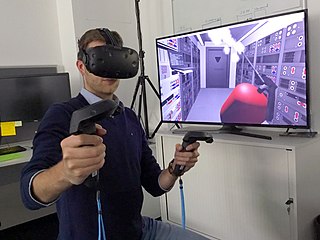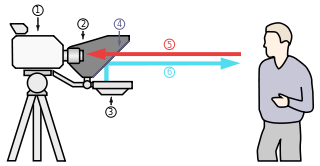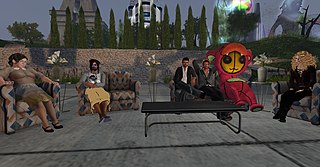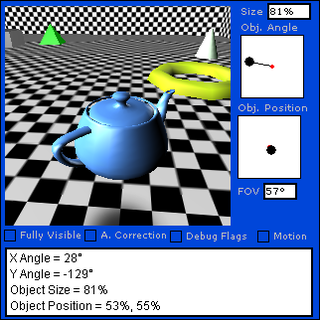Related Research Articles
Multimedia is a form of communication that combines different content forms such as text, audio, images, animations, or video into a single interactive presentation, in contrast to traditional mass media which features little to no interaction from users, such as printed material or audio recordings. Popular examples of multimedia include video podcasts, audio slideshows and animated videos.

Virtual reality (VR) is a simulated experience that can be similar to or completely different from the real world. Applications of virtual reality include entertainment, education and business. Other distinct types of VR-style technology include augmented reality and mixed reality, sometimes referred to as extended reality or XR.

Augmented reality (AR) is an interactive experience of a real-world environment where the objects that reside in the real world are enhanced by computer-generated perceptual information, sometimes across multiple sensory modalities, including visual, auditory, haptic, somatosensory and olfactory. AR can be defined as a system that incorporates three basic features: a combination of real and virtual worlds, real-time interaction, and accurate 3D registration of virtual and real objects. The overlaid sensory information can be constructive, or destructive. This experience is seamlessly interwoven with the physical world such that it is perceived as an immersive aspect of the real environment. In this way, augmented reality alters one's ongoing perception of a real-world environment, whereas virtual reality completely replaces the user's real-world environment with a simulated one. Augmented reality is related to two largely synonymous terms: mixed reality and computer-mediated reality.

The National Science and Media Museum, located in Bradford, West Yorkshire, is part of the national Science Museum Group in the UK. The museum has seven floors of galleries with permanent exhibitions focusing on photography, television, animation, videogaming, the Internet and the scientific principles behind light and colour. It also hosts temporary exhibitions and maintains a collection of 3.5 million pieces in its research facility.
Educational games are games explicitly designed with educational purposes, or which have incidental or secondary educational value. All types of games may be used in an educational environment, however educational games are games that are designed to help people learn about certain subjects, expand concepts, reinforce development, understand a historical event or culture, or assist them in learning a skill as they play. Game types include board, card, and video games.

A teleprompter, also known as an autocue, is a display device that prompts the person speaking with an electronic visual text of a speech or script.

The Game Boy Camera (GBC), released as Pocket Camera in Japan, is a Nintendo accessory for the handheld Game Boy game console. It was released on February 21, 1998, in Japan, and manufacturing was ceased in late 2002. As a toy for user-generated content, it can be used to shoot grayscale photographs, edit them or create original drawings, and transfer images between GBC units or to the 64DD art game suite Mario Artist. The accessory featured a 180°-swivel front-facing camera that allowed users to capture selfies. Its images can be printed to thermal paper with the Game Boy Printer. The GBC's cartridge contains minigames based on Nintendo's early games such as the arcade video game Space Fever and the Game & Watch handheld game Ball, and a chiptune music sequencer. Guinness recognized it as the world's smallest digital camera in 1999, and photographers have embraced its technological limitations as artistic challenges.

A virtual world is a computer-simulated environment which may be populated by many users who can create a personal avatar, and simultaneously and independently explore the virtual world, participate in its activities and communicate with others. These avatars can be textual, graphical representations, or live video avatars with auditory and touch sensations. Virtual worlds are closely related to mirror worlds.
A bishōjo game or gal game, is "a type of Japanese video game centered on interactions with attractive girls". These games are a subgenre of dating sims targeted towards a heterosexual male audience.

In computing, an avatar is a graphical representation of a user or the user's character or persona. Avatars can be two-dimensional icons in Internet forums and other online communities, where they are also known as profile pictures, userpics, or formerly picons. Alternatively, an avatar can take the form of a three-dimensional model, as used in online worlds and video games.

In futurism and science fiction, the metaverse is a hypothetical iteration of the Internet as a single, universal and immersive virtual world that is facilitated by the use of virtual reality (VR) and augmented reality (AR) headsets. In colloquial use, a metaverse is a network of 3D virtual worlds focused on social connection.

Perry Hoberman, is an installation artist who has worked extensively with machines and media. His career has included stints with Laurie Anderson and the USC Interactive Media Division.

A virtual tour is a simulation of an existing location, usually composed of a sequence of videos or still images. It may also use other multimedia elements such as sound effects, music, narration, and text. It is distinguished from the use of live television to affect tele-tourism.
Tobias Bernstrup is a Swedish contemporary artist working with videos, interactive works, live performances and electronic music. He received an MFA from Royal College University of Fine Arts Stockholm in 1998, where he also met up with artist colleague Palle Torsson.

Immersion into virtual reality (VR) is a perception of being physically present in a non-physical world. The perception is created by surrounding the user of the VR system in images, sound or other stimuli that provide an engrossing total environment.

Mark Stephen Meadows (born September 28, 1968), known by his artist name, pighed, is an American author, entrepreneur and artist.

In 3D video games, a virtual camera system aims at controlling a camera or a set of cameras to display a view of a 3D virtual world. Camera systems are used in video games where their purpose is to show the action at the best possible angle; more generally, they are used in 3D virtual worlds when a third-person view is required.
A variety of computer graphic techniques have been used to display video game content throughout the history of video games. The predominance of individual techniques have evolved over time, primarily due to hardware advances and restrictions such as the processing power of central or graphics processing units.
Virtual photography, also known as game photography, screenshot photography, or putsovagery, is a form of new media art which consists of taking screenshots of video game worlds. Virtual photography has been featured in physical art galleries around the world. The validity and legality of this art form is sometimes questioned, because virtual photographers are taking photos of artwork created by the game's designers and artists. For the most part, virtual photographers share the same motivations as "real life" photographers, including a desire to capture visually interesting images, preserve memories, and demonstrating technical expertise.

Youna Kang, better known by her online 3D Virtual YouTuber persona CodeMiko and alias The Technician, is a South Korean-American Twitch streamer and YouTuber. Kang is best known for her live streams on Twitch, interviewing other streamers, content creators and internet personalities as her alter ego persona CodeMiko and for pushing the envelope with regards to interactivity in VTuber technology.
References
- ↑ Brain Pickings, Maria Popova. "Alter Ego: Portraits of Gamers Next to Their Avatars", 2011
- ↑ CCC Strozzina, "Robbie Cooper", 2011
- ↑ Wallpaper, "Robbie Cooper: Immersion", 2010
- ↑ New York Times Magazine "Immersion", 2008
- ↑ Wallpaper, "Immersion: Porn", 2009
- ↑ National Science and Media Museum YouTube, "Interview with Robbie Cooper", 2010
- ↑ National Science and Media Media Museum, "Robbie Cooper: Immersion", 2010
- ↑ 'Phonar Open Online Photography', "Robbie Cooper: Immersion", 2012
- ↑ Cinedigm, "Visitors Official Launch Trailer", 2013